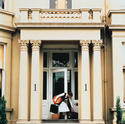 In the early 1980s Glasgow did not have an image that encouraged tourists to sample its attractions. To overcome this, a radical approach was required. An event-led strategy was adopted using the opportunity to host the National Garden Festival in 1988 as the vehicle to address the UK "Short Break" market. The opening of the Scottish Exhibition and Conference Centre (SECC) allowed the city to develop as a successful conference destination.
In the early 1980s Glasgow did not have an image that encouraged tourists to sample its attractions. To overcome this, a radical approach was required. An event-led strategy was adopted using the opportunity to host the National Garden Festival in 1988 as the vehicle to address the UK "Short Break" market. The opening of the Scottish Exhibition and Conference Centre (SECC) allowed the city to develop as a successful conference destination.
 Undoubtedly, the biggest single impact on Glasgow's development as a tourist destination was winning the designation of Cultural Capital of Europe 1990. This provided the opportunity to celebrate the cultural provision the city enjoyed, but of which few outside Scotland were aware. Many potential visitors did not appreciate that Glasgow had one of the UK's finest civic collections including the world famous Burrell Collection. Glasgow also deserved promotion as the home of Scottish Opera, the Scottish National Orchestra, Scottish Ballet, and the Citizens Theatre. The city's Victorian architecture was unmatched and it was the home of the celebrated architect Charles Rennie Mackintosh and his masterpiece the Glasgow School of Art.
Undoubtedly, the biggest single impact on Glasgow's development as a tourist destination was winning the designation of Cultural Capital of Europe 1990. This provided the opportunity to celebrate the cultural provision the city enjoyed, but of which few outside Scotland were aware. Many potential visitors did not appreciate that Glasgow had one of the UK's finest civic collections including the world famous Burrell Collection. Glasgow also deserved promotion as the home of Scottish Opera, the Scottish National Orchestra, Scottish Ballet, and the Citizens Theatre. The city's Victorian architecture was unmatched and it was the home of the celebrated architect Charles Rennie Mackintosh and his masterpiece the Glasgow School of Art.
 The city mounted an ambitious programme of events that attracted the attention of the world's media and permitted the city access to a "fast track" of inward investment. The image of Glasgow was transformed and the city embarked on a dramatic period of self-sustaining growth. Today more people are employed in the tourism industry than were ever employed on Clyde Coast shipping in its heyday. This transformation of Glasgow's fortunes was due to many public, private and voluntary sector agencies working together in partnership.
The city mounted an ambitious programme of events that attracted the attention of the world's media and permitted the city access to a "fast track" of inward investment. The image of Glasgow was transformed and the city embarked on a dramatic period of self-sustaining growth. Today more people are employed in the tourism industry than were ever employed on Clyde Coast shipping in its heyday. This transformation of Glasgow's fortunes was due to many public, private and voluntary sector agencies working together in partnership.